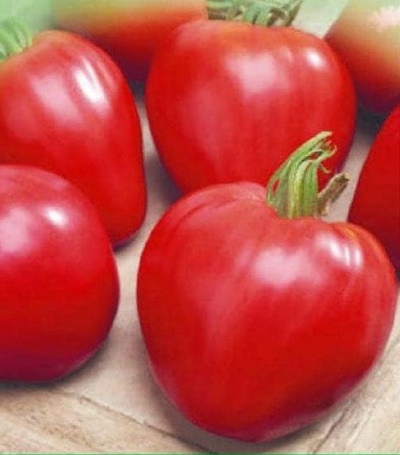
- Authors: M. K. Domanskaya, V. N. Gubko, I. S. Salmina, O. A. Zhitnekovskaya, Federal Research Center Institute of Cytology and Genetics of the Siberian Branch of the Russian Academy of Sciences
- Year of approval: 2017
- Category: grade
- Growth type: indeterminate
- Appointment: fresh consumption, for whole-fruit preservation, for juice, for ketchup and tomato paste
- Ripening period: mid-early
- Ripening time, days: 100-105
- Growing conditions: for open ground, for film greenhouses
- Marketability: good
- Transportability: high
Distributing space on the site for planting tomatoes, many gardeners prefer to plant most of them with multi-purpose varieties that are unpretentious in care. These include the mid-early tomato with the majestic name Vladyka, which grows both in the garden bed and in the film greenhouse.
Breeding history
The mid-early tomato Vladyka is the result of the work of a group of Novosibirsk breeders (V.N. Gubko, I.S.Salmina, O.A. in 2017. The variety gained access to cultivation in all climatic zones of the country. The variety is equally productive both in the garden bed and in unheated greenhouses.
Description of the variety
The Lord is a tall plant of an indeterminate type. The bush grows to a height of 170-190 cm. It is characterized by an average leafiness of a dark green color, a strong central stem, a developed root system and complex inflorescences. The first cluster with fruits is formed above the 9th leaf. On a healthy bush, 5 brushes are formed with 6-8 berries in each.
When growing plants, the bushes should be formed into 1-2 stems, regularly remove the appearing stepchildren, periodically thin out the foliage in the lower part, and also tie them to supports or trellises. The purpose of tomatoes is universal, so they are suitable for eating fresh, pickled, dried and canned. In addition, tomatoes are good for processing into dressings and juices.
The main qualities of the fruit
Vladyka is a representative of large-fruited nightshades. The average weight of a tomato is 204 grams. The vegetable stands out for its beautiful heart-shaped shape with a convex top and a slight ribbing of the surface. A ripe vegetable has a rich raspberry color, and at the stage of technical maturity, the tomatoes are covered with a light green color with darkening at the base. The peel of the vegetable is thin, glossy, but absolutely not tough. The fruit is resistant to surface cracking. Keeping quality and transportability of tomatoes is average. Overripe tomatoes are recommended to be eaten or processed immediately.
Taste characteristics
The taste of the vegetable is excellent. Tomato pulp is characterized by medium density, meatiness, delicate texture and juiciness. In the context, the pulp is bright pink with sugar content. The taste of the vegetable is harmonious, sweetish with a slight sourness, complemented by a pronounced aroma. There are few seeds in the pulp.
Ripening and fruiting
Medium early tomatoes. From the first sprouts to ripe berries on the clusters, 100-105 days pass. The first tomatoes can be tasted at the end of June, and the peak of fruiting occurs in July-August.
Yield
The variety is fruitful.By following the standard agronomic recommendations, the plant will certainly respond with a good harvest. On average, 6.4 kg of juicy tomatoes can be harvested per 1 m2.
The timing of planting seedlings and planting in the ground
The seedling method is considered convenient for growing. Sowing seeds can be done in March, in the second half. Seedlings are pre-sorted out, disinfected and treated with a growth stimulant. Mass germination occurs on the 6-8th day. If desired, you can apply the greenhouse effect by covering the seedlings with plastic or glass. In addition, it is recommended to observe temperature and light conditions.
At the stage of the appearance of several leaves, the bushes should be planted in separate pots. When growing seedlings, do not forget about watering and feeding. Experienced summer residents recommend hardening tomato bushes 2 weeks before transplanting to a new place, which will soften the addiction of plants.
You can transplant seedlings to the garden in late May - early June, when the earth and air are well warmed up. Bushes are planted at the age of 55-65 days.

Growing tomato seedlings is an extremely important process, because it largely depends on whether the gardener will be able to harvest at all. All aspects must be taken into account, from seedbed preparation to planting in the ground.
Landing scheme
It is necessary to place the bushes in the garden, taking into account the peculiarities of the growth of plants, their dimensions. 3-4 bushes can be planted per 1 m2, no more. The recommended layout for planting is 60x50 cm.

Growing and care
Tomatoes are not capricious in their care, they quickly adapt to the climate, but they are a little demanding on the soil. The soil should be fluffy, breathable, fertile. The site should be chosen sunny, sheltered from the winds. Care includes: watering with warm water, fertilizing, loosening the soil, forming, tying and pinching bushes, as well as preventing diseases and insect infestations.




A plant needs different micronutrients at each stage of growth. All fertilizers can be divided into two groups: mineral and organic. Folk remedies are often used: iodine, yeast, bird droppings, eggshells.
It is important to observe the rate and period of feeding. This also applies to folk remedies and organic fertilizers.
Disease and pest resistance
The high immunity of the crop provides protection against a number of common nightshade diseases - tobacco mosaic virus, root and apical rot, alternaria. The only disease that the tomato is exposed to by the end of the growing season is cladosporium.


Resistant to adverse weather conditions
The Vladyka tomato is endowed with high stress resistance. It tolerates temperature fluctuations, short cold snaps, drought and heat. The plant reacts poorly to excess moisture and drafts.

























































































